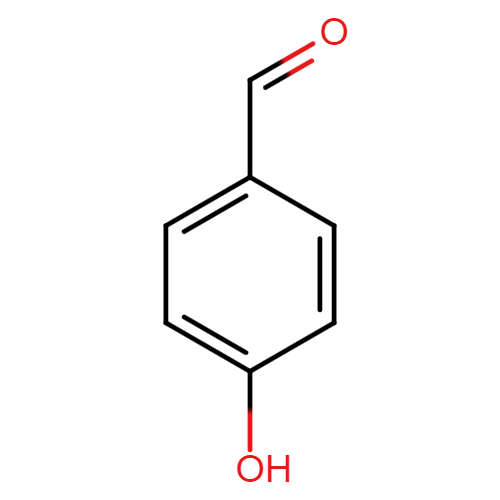4-Hydroxybenzaldehyde
| Compound Structure: |

|
||||||||||||||||||||||||||||||||||||||||||||||
|---|---|---|---|---|---|---|---|---|---|---|---|---|---|---|---|---|---|---|---|---|---|---|---|---|---|---|---|---|---|---|---|---|---|---|---|---|---|---|---|---|---|---|---|---|---|---|---|
| Synonyms: | 4-hydroxybenzaldehyde;p-Hydroxybenzaldehyde;123-08-0;4-Formylphenol;p-Formylphenol;p-Oxybenzaldehyde;Benzaldehyde, 4-hydroxy-;Parahydroxybenzaldehyde;Benzaldehyde, p-hydroxy-;4-HYDROXY-BENZALDEHYDE | ||||||||||||||||||||||||||||||||||||||||||||||
| Compound ID: | NMPC-418 | ||||||||||||||||||||||||||||||||||||||||||||||
| PubChem ID: | |||||||||||||||||||||||||||||||||||||||||||||||
| Molecular Formula: | C7H6O2 | ||||||||||||||||||||||||||||||||||||||||||||||
| Canonical SMILES: | C1=CC(=CC=C1C=O)O | ||||||||||||||||||||||||||||||||||||||||||||||
| InChIKey: | RGHHSNMVTDWUBI-UHFFFAOYSA-N | ||||||||||||||||||||||||||||||||||||||||||||||
| About the compound: | 4-Hydroxybenzaldehyde, a chemical entity with the formula C7H6O2, presents as a yellow to tan powder. It features a molecular weight of 122.123 g/mol, a density of 1.129 g/cm³ at 130 °C, and melts at 116 °C. This substance dissolves moderately in water, with a solubility rate of 12.9 g/L, and possesses an acidity (pKa) of 7.61 at 25 °C. Its production process includes reacting phenol with chloroform to create isomeric hydroxybenzal chlorides, which are then hydrolyzed to form the aldehyde. Serving as a forerunner to 4-hydroxyphenylglycine, a key component in synthesizing penicillins, it also takes part in the Dakin oxidation reaction with hydrogen peroxide in an alkaline medium to produce hydroquinone. Naturally occurring in various plant types such as carrots (Daucus carota), Gastrodia elata, Galeola faberi, and Vanilla orchids, it plays a significant role in the biosynthesis of several compounds[1]. A density functional theory investigation provides insight into the electronic structure and characteristics of 4-OH aldehydes, including 4-hydroxybenzaldehyde. This analysis involves structural optimization and examines the compound's electrostatic potential, electrophilicity, chemical potential, among other attributes crucial for understanding its stability and reactive capabilities. Such research points to its utility across diverse fields, leveraging its structural and spectroscopic qualities for applications in the food, cosmetic, chemical, and pharmaceutical sectors [2]. Extensive studies on secondary metabolites from fungi, particularly those in the Biscogniauxia genus, reveal a significant variety of bioactive molecules, with over 50 taxa identified globally. Investigations into Biscogniauxia have uncovered 115 chemical substances, underscoring the genus's relevance in the search for new medicinal products. This detailed examination of Biscogniauxia's natural products emphasizes the value of secondary metabolites in the quest for innovative pharmaceutical solutions [3]. References 1. Wikipedia contributors. "4-Hydroxybenzaldehyde." Wikipedia, The Free Encyclopedia. https://en.wikipedia.org/wiki/4-Hydroxybenzaldehyde. 2. Khanam, H., Singh, R., and Pandey, J. "A Density Functional Theory Study of 4-OH Aldehydes." Chemistry Proceedings. MDPI, 2023. https://www.mdpi.com/2673-4583/14/1/90. 3. Harneti, D., Safriansyah, W., Rahmawati, Wulandari, A. P., Mulyani, Y., and Supratman, U. "Secondary Metabolites of Biscogniauxia: Distribution, Chemical Diversity, Bioactivity, and Implications of the Occurrence." Toxins. MDPI, 2023. https://www.mdpi.com/2072-6651/15/12/686. GHS Hazard Statements • H315 (39.38%): Causes skin irritation [Warning Skin corrosion/irritation] • H318 (60.1%): Causes serious eye damage [Danger Serious eye damage/eye irritation] • H319 (39.38%): Causes serious eye irritation [Warning Serious eye damage/eye irritation] • H335 (31.09%): May cause respiratory irritation [Warning Specific target organ toxicity, single exposure; Respiratory tract irritation] |
||||||||||||||||||||||||||||||||||||||||||||||
| Properties: |
Chemical
and Physical Properties
Source: PubChem |
||||||||||||||||||||||||||||||||||||||||||||||
| Source Species: |
Talinum triangulare |